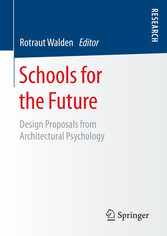Search and Find
Service
Foreword
5
References
8
Preface
9
Table of Contents
11
1 Introduction
14
1.1 Overview
14
1.1.1 Methodological Considerations Regarding Architectural Psychology Relationships
16
1.1.2 Historical Perspectives
18
1.1.3 The School of the Future
19
1.1.4 International Perspectives
20
1.1.4 Developing the Idea of “Schools for the Future”
21
1.1.5 Criteria For the Evaluation of School Buildings
22
1.1.6 Conclusion: How Should Schools Be Built or Renovated? What Makes a School a “School of the Future”?
22
1.2 Questions
25
1.3 Significance of the Topic
27
1.4 Schools Claiming to Be “Schools of the Future”
31
1.5 The Architect’s Leadership Role
32
References
32
2.1 History of the Schoolhouse in the USA
35
2.1.1 Introduction
35
2.1.2 Educational Architecture in the Colonial Period
36
2.1.3 Educational Architecture of the Industrial Revolution
38
2.1.4 Educational Architecture in the Information Age
41
References
51
2.2 Historical Background of the Japanese School
53
2.2.1 A Brief History of Japanese School Planning
53
References
62
2.3 The Historical Development of School Buildings in Germany
63
2.3.1 Emerging Organized Schooling in Germany
63
2.3.2 School Buildings in Cities and Villages
66
2.3.3 Reform Pedagogy (1890–1932)
69
2.3.4 The “Reform Wave” (1918–1933)
74
2.3.5 The National Socialist Takeover
76
2.3.6 The Postwar Period
77
2.3.7 School Construction Today
80
2.3.8 Perspectives for the Future
94
2.3.9 Summary
95
References
96
3 The School of the Future: Conditions and Processes – Contributions of Architectural Psychology
100
3.1 Requirements and Wish List
100
3.1.1 Psychological Processes
101
3.1.2 Spatial Perception
102
3.1.3 Sensory Perception of Architecture
102
3.1.4 Spatial Conditions
104
3.1.5 Children’s Scale
104
3.2 Color Scheme
105
3.2.1 Colors
105
3.2.2 Color Perception
106
3.3 Form Design
108
3.4 Lighting in Schools
109
3.5 Heating, Cooling, and Ventilation
112
3.6 Acoustics and Noise
113
3.7 Furniture and Equipment
117
3.7.1 Media Tools and Instructional Aids
117
3.7.2 Furniture
118
3.8 Density and Crowding
119
3.8.1 Privacy
120
3.8.2 Conflicts and Aggressive Behavior
121
3.8.3 Schools as Places for Encounter
122
3.9 Participation and User Design
124
3.9.1 Acceptance of the School Building: “My (Our) School”
125
3.9.2 Further Development Without the Architect
126
3.9.3 Organizing a Project Group: Students, Teachers, Parents, Sponsoring Groups
126
3.9.4 Preventing Vandalism Inside and Outside the School Building
127
3.9.5 Development of House Rules
128
3.9.6 User Design
128
3.9.7 Creating a Stimulating Environment
130
3.9.8 User Initiative
130
3.9.9 Self-Control and Self-Motivation
131
3.9.10 Appropriation
133
3.10 Ecological Aspects
134
3.10.1 Odors
134
3.10.2 Walls
135
3.10.3 Floors
136
3.10.4 Decks and Ceilings
137
3.10.5 Energy Conservation and Economic Aspects
137
3.10.6 Design of Outside Areas, School Grounds
138
3.10.7 Environmental Education
140
3.11 Organizational Aspects
141
3.11.1 Ease of Access
142
3.11.2 Placement of Entrances, Staircases, and Specialty Rooms
142
3.11.3 Signage and Wayfinding
143
3.11.4 Safety and Security
143
3.12 After-Hours Use of Schools
144
3.12.1 Opening the School to the Community
144
3.12.2 Inclusion of Community and Educational Institutions
145
3.12.3 Adult Education Centers
145
3.13 Conclusion
146
References
148
4 Schools Designed with Community Participation
160
4.1 Benefits of Community Participation
160
4.2 Davidson Elementary School as the Center of a Community
162
4.2.1 Overview
162
4.2.2 Introduction
163
4.2.3 Group Interaction Methods
164
4.2.4 Design Development
169
4.2.5 Post-Occupancy Evaluation
171
4.2.6 Sense of Ownership
173
4.2.7 Conclusion
174
4.3 A Community School Designed for Accessibility
175
4.3.1 Overview
175
4.3.2 Community Design Process
176
4.3.3 Inclusive Design Assessment
176
4.3.4 Conclusion
179
4.4 Summary
179
References
181
5 Trends in the Design and Planning of Schools from the Viewpoint of Information Technology and Communication
183
5.1 The Current State of Learning and Information Technology in Schools
183
5.2 Cases of Innovative Schools Worldwide
184
5.2.1 Gunma International Academy
184
5.2.2 Akemi Minami Elementary School and Akemi Middle School
186
5.2.3 The School of Environmental Studies
187
5.2.4 Crosswinds Arts and Science Middle School
187
5.2.5 Great Binfields Primary School
189
5.2.6 The Classroom of the Future at Meadlands Primary School, Grey Court Secondary School and Strathmore School
189
5.2.7 Fredrika Bremer Gymnasiet Förslag (Upper Secondary School)
190
5.2.8 Futurum Haboskolan
190
5.2.9 Torpparinmaen School
192
5.2.10 Montessori College Oost
192
References
193
6 A Design Language for Schools and Learning Communities
194
6.1 Design Communication
194
6.2 Pattern Language
196
6.3 Developing Patterns
196
6.4 A Language of School Design
198
6.4.1 Home as a Template for School
199
6.4.2 Space for Collaboration
200
6.4.3 The Learning Studio and the Learning Suite
201
6.4.4 The Small Learning Community
203
6.5 Bringing It All Together
205
6.6 Summary
207
References
208
7 Criteria for the Judgment of the Quality of School Buildings
210
7.1 Procedure
210
7.2 Development of a System for Judging the Quality of Schools of the Future
221
References
222
8 Conclusion: What Makes a School a “School of the Future”?
232
8.1. General Recommendations for School Building and Environment
233
8.2 Summary
238
8.3 The Outlook for Schools of the Future
240
References
241
Contributors
243
Acknowledgments
247
Appendix
250
Descriptions and Photographs of 24 School Examples from 11 Countries on 5 Continents
251
Schools as Living, Empowering Places
298
From a Creative Knowledge to Creative Ignorance
302
All prices incl. VAT













